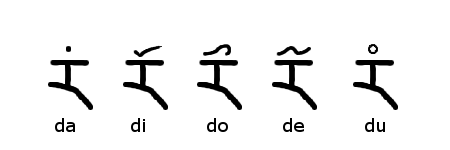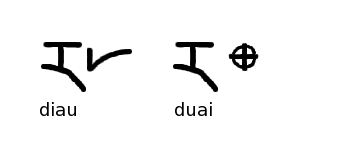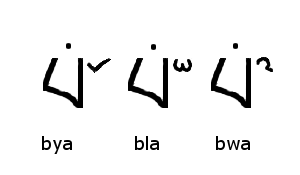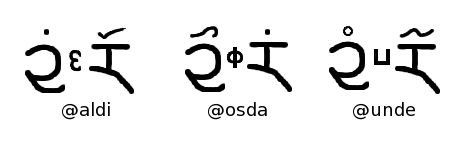Seuna : Chapter 1
Consonants
These are the 17 consonants. All these sounds will be familiar to English speakers apart from "@". The ampersand "@" is used here to represents the glottal stop although some would argue that it would have been better to use the I.P.A. (International Phonetic Alphabet) symbol " ʔ ". The glottal stop is a consonant found in many languages. In English the feature is represented, for example, by the hyphen in uh-oh! and by the apostrophe in Hawaiʻi among those attempting an authentic pronunciation of that name.
The 17 symbols chosen to represent these 17 consonants are more or less copied from Tibetan. These symbols were chosen as it was felt that : although all 17 symbols were very distinct from each other, at the same time they seemed to share a common theme.
There is no correspondence between the phonetic values given here and how they are pronounced in Tibet.
Also there is also no correspondence between how a sound "feels" and how it is written. If there was such a correspondence "s" would be extremely smooth, the nasals would be quite smooth and "k", "p" and "t" would be extremely angular. This does not happen.
There is no scheme that gives these symbols common elements corresponding to common articulation methods. However it can be noted that "b", "p" and "m" have a common element. As do "h" and "@". Also "g" and "y" are quite similar and diachronically "g" => "y" is quite a common sound change.
In Seuna, these above 17 symbols are called mozga (plural mozgai). The Seuna for "alphabet" is mozgaiya.
Vowels
The vowel marks are given below. They are written above the consonants that they follow so they are demonstrated here over "d" .
A short explanation of allophones
The allophone is a very interesting linguistic phenomenon. But how to explain it ...
O.K. take the word "Mitsubishi". Now this is how a Native English Speaker (NES) wrote down this Japanese word in the Latin alphabet. However a Native Japanese Speaker (NJS) would have written this word as "Mitubisi" in the Latin alphabet. It is a feature of Japanese that that when "t" is followed by "u". the "t" is always released with such force, that it sounds (to a NES) as if there is an "s" between the "t" and the "u". Also a feature of Japanese is that when "s" is followed by "i", the vowel sound influences where the tongue gets close to the roof of the mouth in the making of the "s" sound, so that to a NES the sound is heard as a "sh" sound.
In technical language, it would be said that "sh" is an allophonr of "s" and "ts" is an allophone of "t" in Japanese .
To the NJS's ear and brain the two sounds "s" and "sh" are exactly the same and the two sounds "t" and "ts" are exactly the same. If a NES was to try and convince a NJS (who hadn't studied phonology) that "s" and "sh" were two different sounds, he could argue until he was blue in the face, the NJS just would not get it.
Allophones in Seuna
Seuna has a few allophones.
One that Seuna shares with Japanese is that "s" is pronounced "sh" before "i". The I.P.A. symbol for this sound is "ʃ". I will use the I.PA. symbol from now on when transcibing this sound.
Another it that when "s" is between two voiced sounds word internally, it is pronounced as "z". By the way "m y j b g d l w n a i o e and u" are voiced sounds.
When the environment that produces "ʃ" and the environment that produces "z" co-exist. It is the "ʃ" sound that is prevails. For example the Seuna word meaning correct, is @iʃi and not @izi.
Another allophone is that when "n" is followed by "k" or "g" it is pronounced as in the final sound in the English word "sing". The I.P.A. symbol for this sound is "ŋ". I will use the I.PA. symbol from now on when transcibing this sound.
Vowel clusters
Clusters of 2 vowels
The six diphthongs that are made up of combinations of two of the above simple vowels are shown below.
Clusters of 3 vowels
The two diphthongs that are made up of combinations of three of the simple vowels are shown below.
Consonant clusters
Word-initial constant clusters
In the same way that you can get sequences of vowels to flow into each other and produce diphthongs, clusters of consonants can occur. Given below is a list of consonants and consonant clusters which are allowed to start a word. There are 37 of them.
| @ | |||
| m | my | ||
| y | |||
| j | jw | ||
| f | fy | fl | |
| b | by | bl | bw |
| g | gl | gw | |
| d | dw | ||
| l | |||
| c | cw | ||
| s | sl | sw | |
| k | ky | kl | kw |
| p | py | pl | |
| t | tw | ||
| w | |||
| n | ny | ||
| h |
z is an allophone of s ... when inside a word and before a voiced consonant.
ʃ is also an allophone of s ... when before the front vowels i or ia.
ŋ is an allophone of n ... when followed by k or g.
The post-alveolar affricates are represented here by c and j, are the initial sounds of "Charlie" and "Jimmy" respectively. .
The consonant r is exceptional in that it only occurs in suffixes attached to active verbs.
An off-gesture (or off-flurish) is when a consonant is immediately followed by "y","l" or "w". Off-gestures only occur word initially and are restricted to certain letters (see "initial consonant clusters" in "Seuna word shape"). The off-gesture is indicated by a mark placed just to the top right of the main figure (see below).
Mid-word constant clusters
The single consonants and consonant combinations given below are allowed word internally. There are 53 of them.
| @ | m | y | j | f | b | g | d | l | c | s | k | p | t | w | n | h |
| lm | ly | lj | lf | lb | lg | ld | lc | ls | lk | lp | lt | lw | ln | |||
| ny | nj | nf | mb | ŋg | nd | nc | ns | ŋk | mp | nt | mw | |||||
| sm | sy | sb | sg | sd | sl | sk | sp | st | sw | sn |
Actually the clusters -sm- -sy- -sb- -sg- -sd- -sl- -sw- and -sn- would be better represented by -zm- -zy- -zb- -zg- -zd- -zl- -zw- and -zn-.
An on-gesture (or on-flurish) is when a non-initial-consonant is preceded by "l", "s" or "n". These on-gestures co-occur with most consonants but a very few combinations are disallowed(see "mid consonant clusters" in "Seuna word shape").
The on-gesture is indicated by a mark placed just to the left of the figure that they are combined with(see above).
End-word constant clusters
Actually most words are only two syllables long. However about 30 % have three syllables. For this third syllable, only the 17 simple consonants are allowed.
| @ | m | y | j | f | b | g | d | l | c | s | k | p | t | w | n | h |
Index
- Introduction to Seuna
- Seuna : Chapter 1
- Seuna word shape
- The script of Seuna
- Seuna sentence structure
- Seuna pronouns
- Seuna nouns
- Seuna verbs (1)
- Seuna adjectives
- Seuna demonstratives
- Seuna verbs (2)
- Asking a question in Seuna
- Seuna relative clauses
- Seuna verbs (3)
- Methods for deriving words in Seuna
- List of all Seuna derivational affixes
- Numbers in Seuna
- Naming people in Seuna
- The Seuna calendar
- Seuna units





